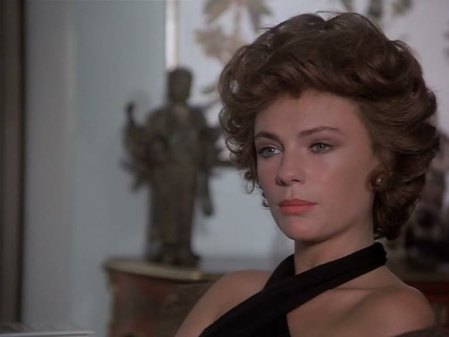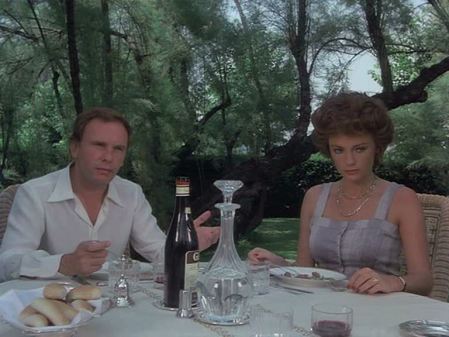David Melville Wingrove returns with another in his series, Forbidden Divas, about one of his very favourite stars — can you tell?
FORBIDDEN DIVAS
Always (and Ever So Discreetly) on a Sunday
“Your obsession with being witty at all costs…it just makes you a bitch.”
~ Marcello Mastroianni to Jacqueline Bisset, The Sunday Woman

For a few short summers in the late 70s, Jacqueline Bisset was the official Most Beautiful Woman in the World. Every hormonally challenged adolescent boy wanted either to sleep with her or to be her – and a few, perhaps, wanted to do both. Nobody even pretended her films were any good. The Deep (1977) was five minutes of La Jackie scuba-diving in a wet T-shirt followed by two hours of…does anyone remember or care? The Greek Tycoon (1978) was the ‘strictly fictional’ story of a US politician’s widow who marries a shipping magnate. It was about as interesting as reading HELLO! magazine with the names changed. Who Is Killing the Great Chefs of Europe? (1978) was a comedy-thriller that was devoid of laughs or thrills – but it did star Bisset as the skinniest dessert chef in the history of haute cuisine.
All these movies were wretched, but the public turned out because Jacqueline Bisset was in them. On a screen ruled by the woeful likes of Sally Field and Marsha Mason and Jill Clayburgh, audiences were starved for a glimpse of a proper old-fashioned star. You know, one with beauty and glamour, style and class. One who wore clothes well but refused – with a frosty ladylike hauteur – to take them off. (In 1978 when Bisset was at the height of her fame, some ungallant souls re-released a sleazy little item called Secrets (1971) where she did precisely that. They did not make as much money as they hoped, perhaps because most of Bisset’s fans were too young to get in to see it.) A star who could even act – when she had to – although that was one secret that Jacqueline Bisset kept largely to herself. Critics used to say she was better than her material. Well, it would take a truly Olympian lack of talent to be worse.

In truth, a number of films had proved that Bisset could act – but most of them were made in Europe and had titles the teenagers who flocked to The Deep could not even pronounce. La donna della domenica (1975) is a tongue-twister even for native Italian speakers but its literal English translation, The Sunday Woman, will do just as well. It was directed by Luigi Comencini, one of those mid-level Italian auteurs – neither an artist nor a hack – whose work is slick and watchable, but only rarely interesting. It takes place amid the upper bourgeoisie of Turin, a photogenic northern city that was the centre of the Italian film industry until World War I, but has been sadly neglected by movies ever since. You might call it a giallo but it is really too refined and elegant for that. This tale of skullduggery and murder never stoops to a display of severed limbs or spurting blood. There may be some erect penises on show – and impressively large ones, too – but these are sculpted in stone for use as decorative objets d’art. Mind you, they also come in handy as murder weapons…
The film opens with Bisset sitting in her stylish Futurist villa, pretending to listen as her industrialist husband drones on about his business. We hear an internal monologue inside her head, saying that “he only ever talks of the economic crisis and his liver.” He also spends most nights away from home with his mistress but Bisset – or her character, Anna Carla Dosio – seems to take that as a point in his favour. Her monologue is addressed, not to herself or to the audience, but to her best friend (Jean-Louis Trintignant) a patrician gay man who rejoices in the name of Massimo Campi. (Let it be said, in fairness, that Trintignant’s performance is remarkably subtle and restrained.) Bisset and her GBF form an exclusive and deeply snobbish clique à deux. They find the rest of Turin society unbearably vulgar and conduct endless debates on the socially acceptable way to pronounce certain words. Their current object of loathing is a fat, lecherous architect who wiggled his tongue at Bisset at an art opening. She is writing a letter to her friend, to decree this man must be eliminated. Things look rather awkward when he promptly turns up dead.

The problem is not that this letter exists, but that it finds its way into the hands of the police. The morning after the murder, Bisset dismisses her Sardinian houseboy for having the temerity to serve a drink without a tray. He pockets her letter (which she has carelessly left lying about) and takes it to one Inspector Santamaria (Marcello Mastroianni) a down-to-earth Roman poliziotto who finds Turin society too rarefied and snooty for words. The cop may not take the letter seriously as a clue – after all, it is a shade too obvious – but he is intrigued by the woman who wrote it. He tumbles quickly to the fact that she is beautiful and bored. Nor does Bisset entirely mind being dragged into a murder investigation. (Her husband, of course, is aghast.) “This is the most exciting thing that’s happened since I got a flat tyre four years ago,” she says at one point. Most exciting is the close proximity of Mastroianni, an actor known for making every woman in every movie he makes…
Most of The Sunday Woman is a stylish pas de deux of mutual attraction and resistance, between the haughty socialite and the earthy cop. It is one of a very few films that explore Bisset’s gift for high comedy in the manner of George Cukor or Mitchell Leisen. (At least Cukor lived long enough to direct her best Hollywood role in the 1981 Rich and Famous.) Learning that the victim was bludgeoned to death with a large stone phallus, she drives Mastroianni out into the country, to the factory that manufactures these objects in secret. Surrounded by a warehouse full of giant cocks, she must fight the temptation – as Lady Bracknell would say – to “look shocked, which is vulgar, or laugh, which is worse.” When the sculptor unveils his king-size model, her composure threatens to crack. She knows that Mastroianni has something quite similar on offer. How much longer can she pretend not to notice?

Her scenes with her gay pal Trintignant are played just as smoothly. It would be two decades before Hollywood dared show a similar friendship – between Julia Roberts and Rupert Everett in My Best Friend’s Wedding (1997) – and they did so with all the matter-of-fact sangfroid of Marie Curie discovering radium. The Sunday Woman takes their alliance as a given, as both characters are too intelligent and ultimately too vulnerable for the vacuous cocktail party world they are forced to inhabit. While Everett’s love life would be kept timidly off screen, Trintignant has a cute but far-too-clingy boyfriend (Aldo Reggiani) who wants to protect his lover and starts his own investigation into the murder. Let’s just say he lacks Bisset’s savoir faire and has no sexy police detective to look out for him…so he comes to a bad end. Our delight in The Sunday Woman is not in the plot but in the supreme elegance with which the characters pick it apart.

Every so often, one grows tired of films that beat the audience over the head with their sheer dogged determination to be Great Art. (The latest Paolo Sorrentino film Youth is an egregious case in point.) The Sunday Woman labours under no such delusions. It confines itself to being witty, sexy, literate, stylish, suspenseful and – once you realise just how arid its characters’ lives truly are – touching in an odd and wholly unexpected way. Jacqueline Bisset has never acted more elegantly or looked more exquisite. She reigns over it all serenely, like a queen to the manner born. Faced with two of Europe’s very greatest actors, she twines each of them neatly round one little finger and then looks about her for more amusement. Did nobody think to impound her passport before she caught that plane back to Hollywood?








